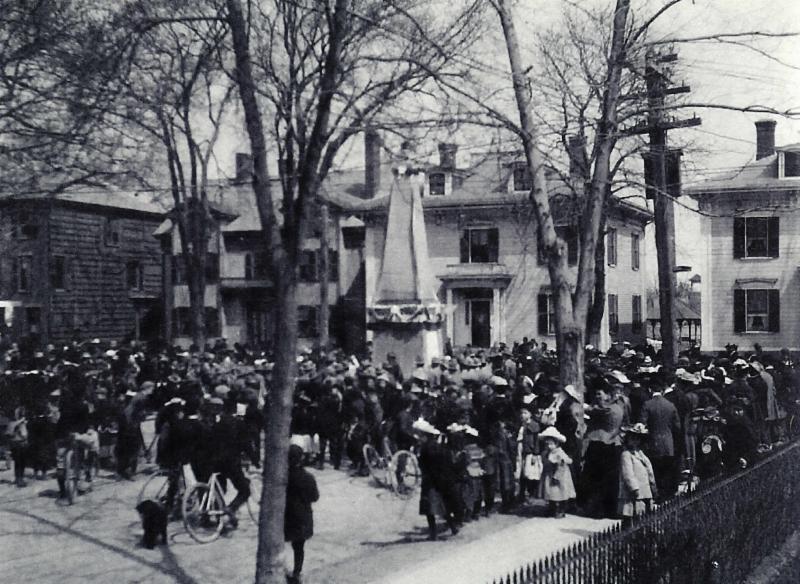PEABODY — Seven local men killed when the Revolutionary War began won’t be forgotten Monday even though coronavirus social distancing precautions have cancelled the annual city remembrance ceremony.
The Peabody Historical Society & Museum posted a notice on its website and sent members an online reminder about the sacrifice made by the seven.
George Southwick, Samuel Cook, Henry Jacobs, Ebenezer Goldthwait, Benjamin Daland, Jotham Webb and Perley Putnam were killed during the April 19, 1775 battles of Lexington and Concord.
Peabody Historical Society & Museum Assistant Curator Nora Bigelow said author John A. Wells’ history, “The Peabody Story,” thoroughly tells the story of the Peabody Seven.
At 9 a.m. on April 19, 1775, according to Wells’ account, word came to Peabody that the British soldiers were marching toward Lexington and Concord. In preparation, the local minutemen had designated the corner of Main and Washington Streets as their meeting location. At that time, the local tavern, Bell Tavern was located at that corner. Later, when the Lexington Monument was erected, it was at this corner.
By 10 a.m., the minutemen had started their march towards Lexington. After 4 hours and 16 miles, they reached the nearby village of Menotomy (the city of Arlington today). The British troops were retreating from Lexington, and it was in Menotomy along Concord Road (now Massachusetts Avenue) that the minutemen encountered them. In these companies, there were over 300 men from Peabody, Danvers and Beverly.
Wells recalls how “The minutemen took strategic cover, some behind walls and trees. They started to shoot at the retreating British troops. Unbeknownst to them, the British soldiers had flanked them. What followed was intense, close-range fighting. A few of the Peabody soldiers took cover in the nearby home of Jason Russell (now the Arlington Historical Society). Some were pursued by British troops and killed.
George Southwick, Samuel Cook, Henry Jacobs, Ebenezer Goldthwait, and Benjamin Daland — all of whom resided in what is today Peabody — were killed in Arlington. Jotham Webb and Perley Putnam — residents of what is now Danvers — were also killed. A salute to the seven is inscribed on the Lexington Monument in Peabody.
At the time of his death, George Southwick was 25. Southwick was reluctant to join the minutemen that day, as his wife was close to giving birth to their child. He could not find a replacement and made a sad farewell to his family.”
Southwick, Dennison Wallis and Joseph Bell found shelter in Jason Russell’s house. When it appeared the British soldiers had moved on, Southwick, Wallis and Bell emerged. However, they were surprised by British soldiers, and Southwick was struck in the head by an enemy sword. Wallis was shot multiple times, but miraculously survived by pretending to be dead. Bell was taken captive by the British and imprisoned two months on an English frigate.
Samuel Cook was 33. Benjamin Daland was 25. Henry Jacobs, Ebenezer Goldthwait and Jotham Webb were 22. Perley Putnam, the youngest, was 21. The deceased were transported back to Peabody and Danvers via ox-cart.
Cook, Southwick, Jacobs and Goldthwait were taken to the home of Samuel Cook, 65 Central Street, to be waked. The funeral services took place in the South Congregational Church. Southwick, Cook, Daland and Goldthwait were buried at the Old South Burial Ground on Main Street, near today’s border with Salem. Henry Jacobs was buried at his family’s cemetery in West Peabody.
Wells recounts how on the 60th anniversary of the Battle of Lexington, in 1835, “the people of Peabody dedicated a monument to honor their fallen men; it was placed at the corner of Main and Washington Streets.” The monument is made of stone quarried off Summit Street.
Samuel Brown quarried and cut the stone. The architect of the monument was the accomplished Asher Benjamin. The cornerstone of the monument was laid on Monday, April 20, 1835. This year, Patriot’s Day would have been celebrated on Monday, April 20, as well.
On April 20, 1835, the ceremony started at 10 a.m. in Peabody Square with a military procession. Participants walked to the Old South Burial Ground to honor the fallen who were buried there. John W. Proctor, Esq. detailed the order of services. Rev. Charles C. Sewall of the First Unitarian Church offered a prayer.
The procession returned to Main and Washington Streets. Nineteen men who had fought in the battle of Lexington, were present at the ceremony. These surviving soldiers placed a box under the cornerstone, containing memorial items and documents. Of these men, 12 were from Peabody and Danvers: Gideon Foster, Sylvester Osborne, Johnson Proctor, Levi Preston, Asa Tapley, Roger Nourse, Joseph Shaw, John Jocelyn, Ephram Smith, Jonathan Porter, Joseph Tufts and William Flint. The remembrances concluded at the Old South Church, which was overflowing with people.
On the 100th anniversary of the Battle of Lexington, another large ceremony took place. General Ulysses S. Grant, then president of the United States, attended the event. A group of Peabody and Danvers men retraced the steps of the minutemen and marched to Lexington.
The monument remained at the corner of Main Street and Washington Street until 1967. There was a serious automobile accident in 1964, where the driver lost control of his vehicle and crashed into the monument. Many grew concerned over the monument’s proximity to the busy street.
The City of Peabody wanted to relocate it but struggled to find an appropriate spot. There were multiple ideas, including moving it to Cedar Grove Cemetery. Ultimately, it was decided that the monument should simply be moved back 25 feet to its current location.
Even with the coronavirus cancellation, Bigelow said the Peabody Seven provide an inspiring story about America’s birth.

